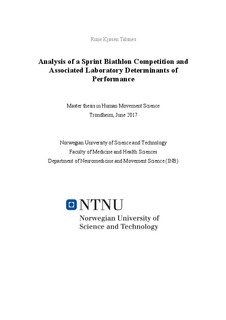| dc.description.abstract | Background: Biathlon is a traditional Olympic winter sport combining cross-country skiing using the skating technique with rifle shooting. Thus, biathlon is a complex sport, that in addition to a high endurance capacity and efficient skiing technique, demands rapid and accurate shooting performed directly after intense exercise. There exist only a few studies on biathlon today, and in particular analysis of high-level competitions are lacking.
Purpose: The present study was designed to investigate a sprint biathlon competition with respect to the contribution of XC skiing and shooting performance on the overall biathlon performance, as well as the relationship to laboratory determinants of performance obtained during treadmill roller skiing.
Methods: Eleven elite male biathletes were tracked by a global positioning system (GPS) device and heart-rate monitor during an international sprint biathlon competition. Within a period of 6 weeks prior to the competition, the participants completed laboratory testing while submaximal and maximal roller skiing on a treadmill.
Results: (1) the XC skiing and shooting performance explained 84% and 14%, whereas shooting time and range time together explained 2% of the overall performance, respectively (all p < 0.01), (2) time in uphill terrain explained 91% of the variation in XC skiing performance (p < 0.01), (3) the shooting performance was not significantly correlated with the biathletes pacing towards shooting, the intensity of exercise or shooting time, and (4) relative heart-rate and rating of perceived exhaustion during submaximal, and time to exhaustion during maximal roller skiing in the laboratory correlated significantly with the XC skiing performance, as well as time in different terrains (r = 0.64-0.95, all p < 0.05).
Conclusion: The present findings reveal that the XC skiing performance exerts greatest influence on the overall performance in the sprint biathlon competition, with rating of perceived exhaustion and relative heart-rate while submaximal roller skiing and treadmill roller skiing performance being significant correlates of the XC skiing performance. | nb_NO |
